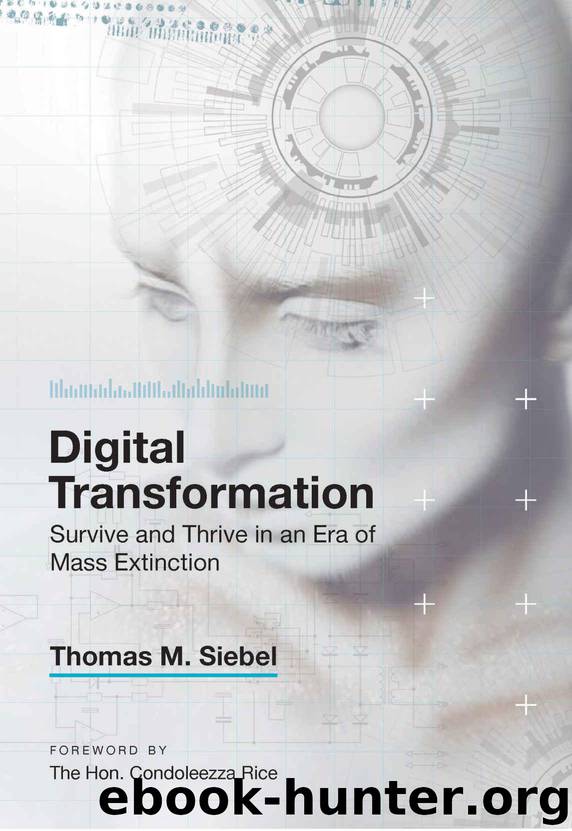Digital Transformation: Survive and Thrive in an Era of Mass Extinction by Thomas M. Siebel

Author:Thomas M. Siebel
Language: eng
Format: azw3
Tags: Industries, Social Aspects, Computers, Computers & Information Technology, Business & Economics
ISBN: 9781948122481
Publisher: Rosetta Books
Published: 2019-07-09T03:00:00+00:00
To address the overall demand for data science skills, governments have begun to act. The UK’s Open Data Institute and Alan Turing Institute, the European Commission’s 2014 big data strategy, and the U.S. federal government’s 2016 Big Data Research and Development Strategic Plan are all examples of coordinated efforts to address the need for trained data scientists. China, which has made AI a central pillar of its thirteenth Five-Year Plan and New Generation of Artificial Intelligence Development Plan, is investing massively in AI research including university programs to train data scientists.42 But China also estimates it will face data scientist shortfalls: In 2016 the information technology ministry estimated China will need 5 million more AI workers to satisfy its needs.
Globally, more traditional research programs are contributing to core research and are publishing papers at a rapid rate. Leading institutions include MIT, Carnegie Mellon, Stanford, and USC in the U.S.; Nanyang Technological University, National University of Singapore, Hong Kong Polytechnic University, Chinese University of Hong Kong, the Institute of Automation, Tsinghua University, and Chinese Academy of Sciences in Asia; University of Grenada and Technical University of Munich in Europe; as well as others in Canada, Switzerland, Italy, the Netherlands, Australia, and Belgium, to name a few.
Data science programs in the U.S. are expanding across many vectors. In 2014, University of California at Berkeley launched an online data science master’s program and now offers an executive education program in data science and analytics. More than 30 high schools in California have started offering data science classes for juniors and seniors.43 Over the longer term, a significant focus on mathematical and computer science education starting in the K-12 curriculum will be required to address the AI skills gap.
There are also a growing number of “boot camps” and training programs for aspiring data scientists. These programs take in professionals with strong technical backgrounds—e.g., mathematics, physics, or other engineering disciplines—to train and prepare them for AI careers. Some of these boot camp courses are available online. For example, Coursera offers an online curriculum for both machine learning and deep learning.44 Other courses are in-person, such as the Insight Data Science program in the San Francisco Bay Area.45
In addition to data scientists, companies will also increasingly need individuals whom McKinsey calls “translators.”46 Translators can bridge the divide between AI practitioners and the business. They understand enough about management to guide and harness AI talent effectively, and they understand enough about AI to ensure algorithms are properly integrated into business practices.
Without a doubt, we are in a transitional time as organizations retrain their workforces, recruit graduates with AI degrees, and adjust to the many changes driven by AI innovation and adoption. But there is a clear path forward for organizations that realize the inevitability of an AI-powered future and the need to start building AI capabilities now. Today organizations can rely on the expertise of AI advisors and proven technology partners while simultaneously developing their own internal AI competencies.
Download
This site does not store any files on its server. We only index and link to content provided by other sites. Please contact the content providers to delete copyright contents if any and email us, we'll remove relevant links or contents immediately.
| Computer Vision & Pattern Recognition | Expert Systems |
| Intelligence & Semantics | Machine Theory |
| Natural Language Processing | Neural Networks |
Algorithms of the Intelligent Web by Haralambos Marmanis;Dmitry Babenko(16233)
Jquery UI in Action : Master the concepts Of Jquery UI: A Step By Step Approach by ANMOL GOYAL(9385)
Test-Driven Development with Java by Alan Mellor(7729)
Data Augmentation with Python by Duc Haba(7606)
Principles of Data Fabric by Sonia Mezzetta(7378)
Learn Blender Simulations the Right Way by Stephen Pearson(7294)
Microservices with Spring Boot 3 and Spring Cloud by Magnus Larsson(7137)
Hadoop in Practice by Alex Holmes(6587)
RPA Solution Architect's Handbook by Sachin Sahgal(6515)
The Infinite Retina by Robert Scoble Irena Cronin(6215)
Big Data Analysis with Python by Ivan Marin(5930)
Life 3.0: Being Human in the Age of Artificial Intelligence by Tegmark Max(5506)
Pretrain Vision and Large Language Models in Python by Emily Webber(4893)
Infrastructure as Code for Beginners by Russ McKendrick(4651)
Functional Programming in JavaScript by Mantyla Dan(4434)
WordPress Plugin Development Cookbook by Yannick Lefebvre(4379)
The Age of Surveillance Capitalism by Shoshana Zuboff(4242)
Embracing Microservices Design by Ovais Mehboob Ahmed Khan Nabil Siddiqui and Timothy Oleson(4146)
Applied Machine Learning for Healthcare and Life Sciences Using AWS by Ujjwal Ratan(4134)
